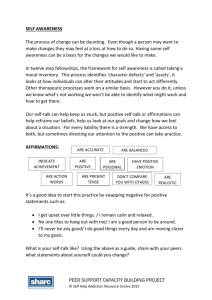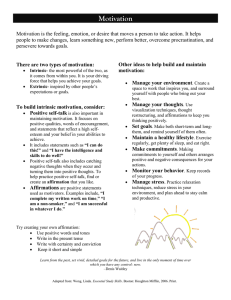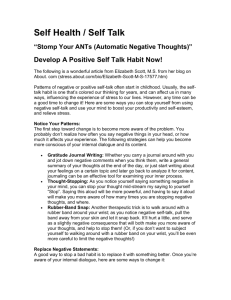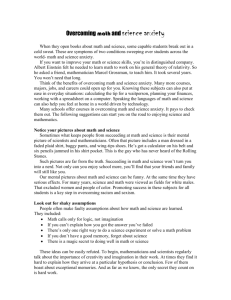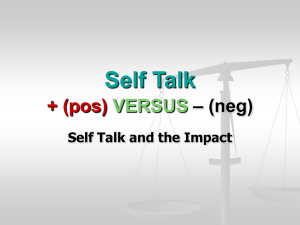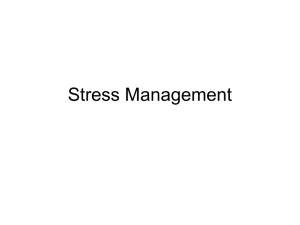WS06 Cognitive Restructuring
advertisement
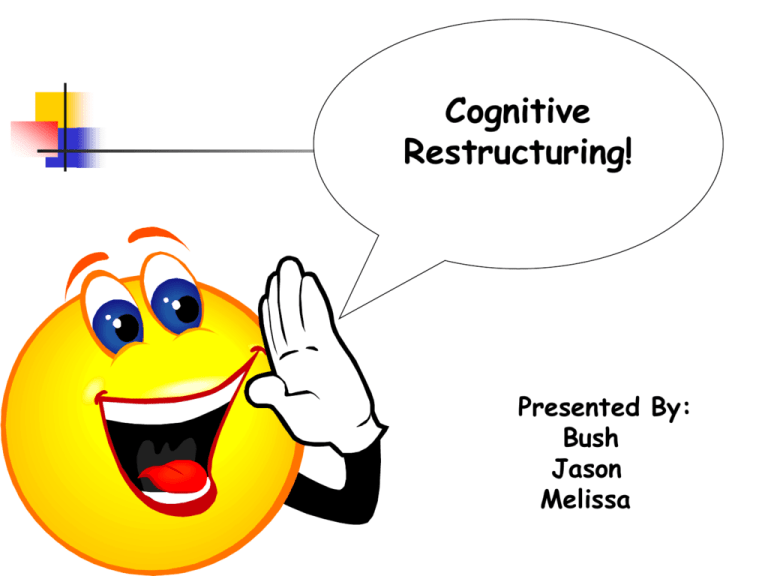
Cognitive Restructuring! Presented By: Bush Jason Melissa Cognitive Restructuring A coping technique; substituting negative, self-defeating thoughts with positive, affirming thoughts that change perceptions of stressors from threatening to non threatening. Term coined by Meichenbaum in 1975 Cognitive Restructuring Cont. Involves assuming responsibility, facing the reality of a situation, and taking the offensive to resolve the issues causing stress. Why use Cognitive Restructuring? Allows you to widen perspective Decreases the intensity of perceived stress Helps change negative self-defeating attitude to a positive one Albert Ellis Rational Emotive Therapy (RET) Stress-related behaviors initiated by perceptions Believed these perceptions could be changed People can be educated to favorably alter negative or stress-related perceptions into positive attitudes Information-Processing Model A model that reveals how we potentially perceive sensory information, for better or worse. (Add in scanned picture) The information-processing model Neurolinguistic Programming (NLP) Richard Bandler & John Grinder A program designed to look at how our thoughts control our language and how our language influences our behavior. By encouraging reprogramming & eliminating negative vernacular words, phrases, & thoughts that reinforce stress-prone behaviors. Toxic Thoughts Repeated negative thought processing that tends to pollute our view of our lives and ourselves. Thought Stopping A coping technique where one consciously stops the run of negative thoughts going through one’s head. When you catch yourself thinking negatively, you interrupt the flow of consciousness and say to yourself “stop this thought” Thought Stopping Worksheet Self-talk The perpetual conversation heard in the mind, usually negative and coming from the critical (ego), which rarely has anything good to say. Types of Negative Self-Talk Pessimism (Looking at the worst of every situation) Catastrophizing (Making the worst of every situation) Blaming (Shifting responsibility from yourself) Perfectionism (Imposing above-human standards on oneself) Polarized thinking (Views are always extreme, extremely good or extremely bad) Should-ing (Things you should have done) Magnifying (blowing things out of proportion) Using Self-Talk Efficiently Recall Journal 17 (positive affirmations) Phrase in the present tense Phrase in a positive way Make simple, clear, and precise Choose one that feels right for you EX. I radiate success I am a beautiful human being I am calm and relaxed Self-Talk Worksheet Assessing the Effectiveness of Self-Talk Interventions on Endurance Performance Authors: Ryan Hamilton, David Scott, & Michael MacDougall 3 different self-talk interventions were used on 9 endurance cyclists Cyclists were told to cycle as far as they could for 20 min, 2x week for 5 weeks Results Self-regulated positive self-talk: cyclists read statements, “My legs are strong”, “I can maintain this pace” (performance increased) Assisted positive self-talk: cyclists listened to audiotapes with positive statements (highest performance increase) Assisted negative self-talk: cyclists listened to audiotapes with negative statements, “My legs are weak”, ”I can’t maintain this pace” (2 out of 3 improved performance) Steps to Initiate Cognitive Restructuring Awareness Reappraisal of the situation Adoption and Substitution Evaluation Tips & Suggestions Initiate a relaxation technique to calm your mind Take responsibility for your own thoughts Fine-tune expectations Give yourself positive affirmations Accentuate the positive Healthy Thoughts to Reduce Stress Nobody’s perfect, not even me Gray is sometimes the best color The swoosh principle: Just do it I will survive, whether you like me or not Only Zebras cannot change their stripes http://www.kstate.edu/paccats/Contents/Stress/Cognitive%20Restructuring.p df
